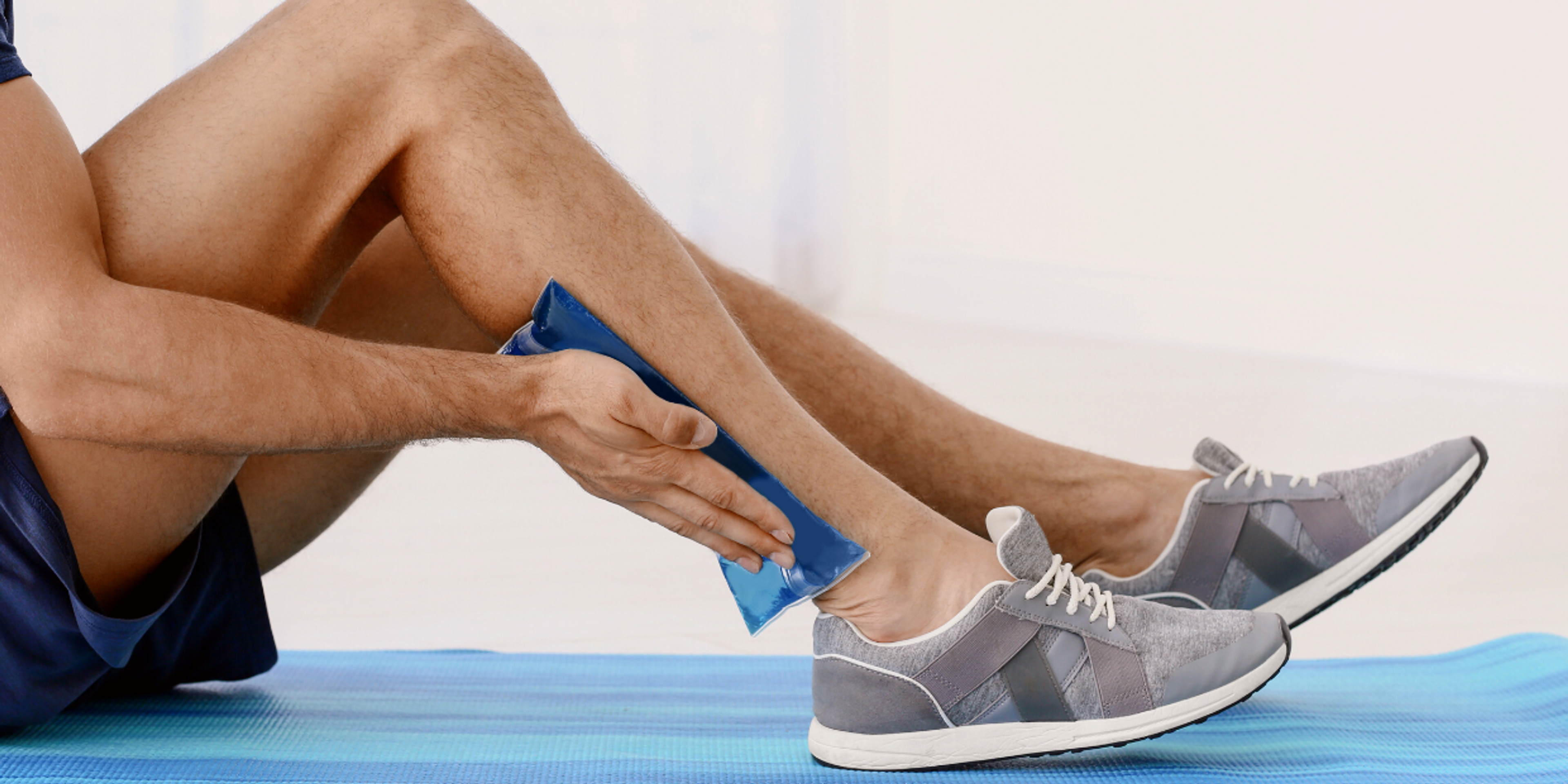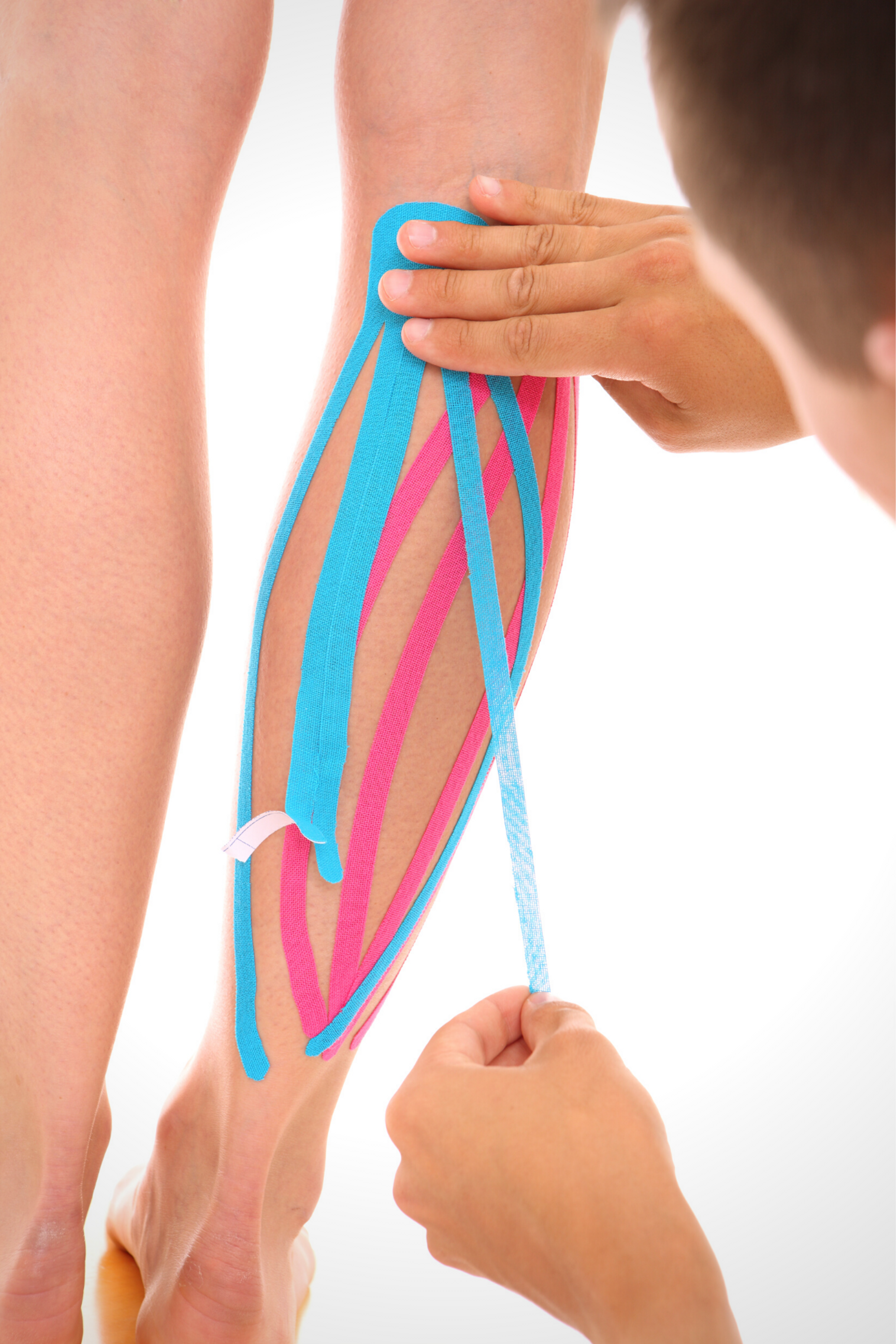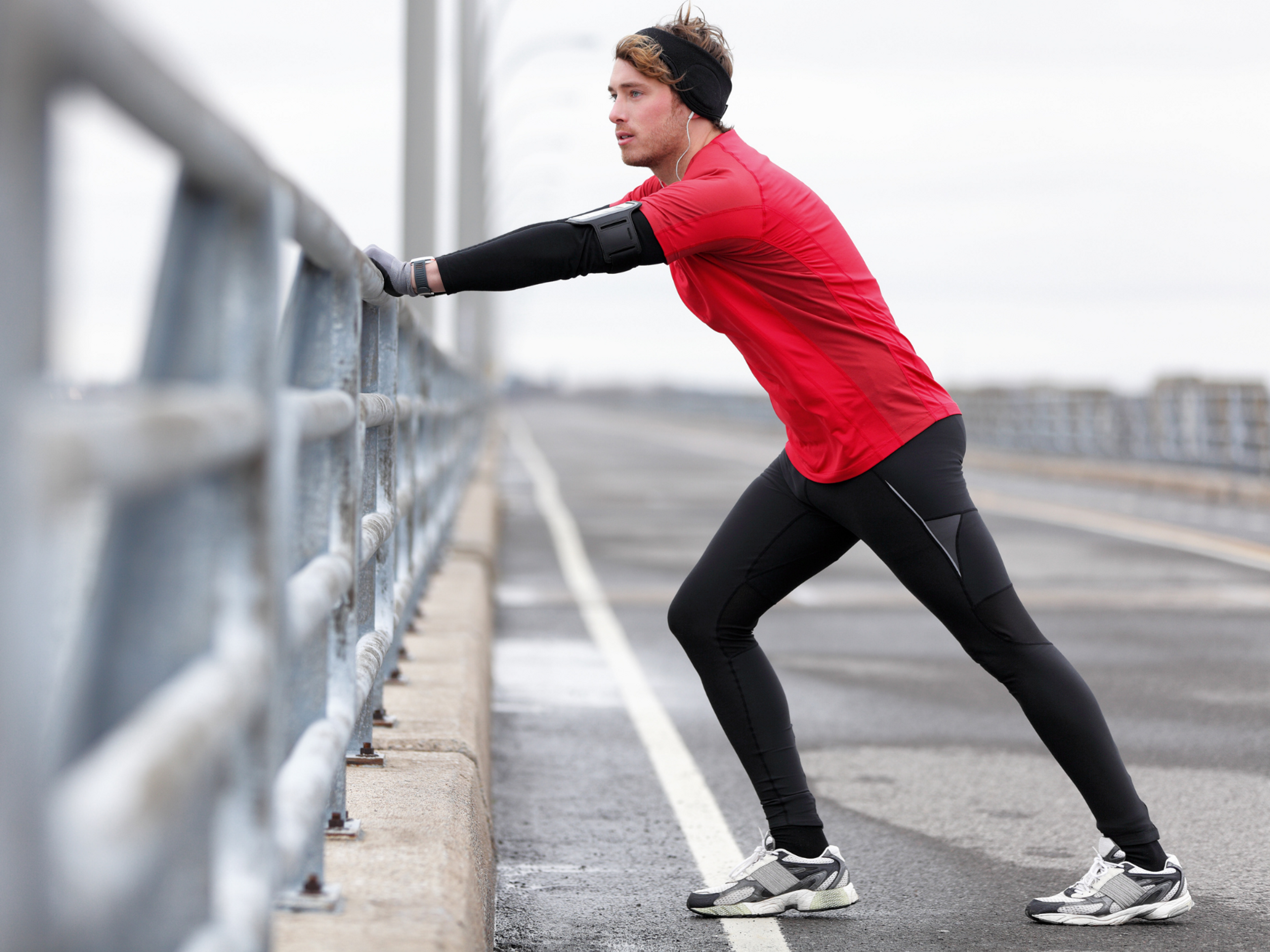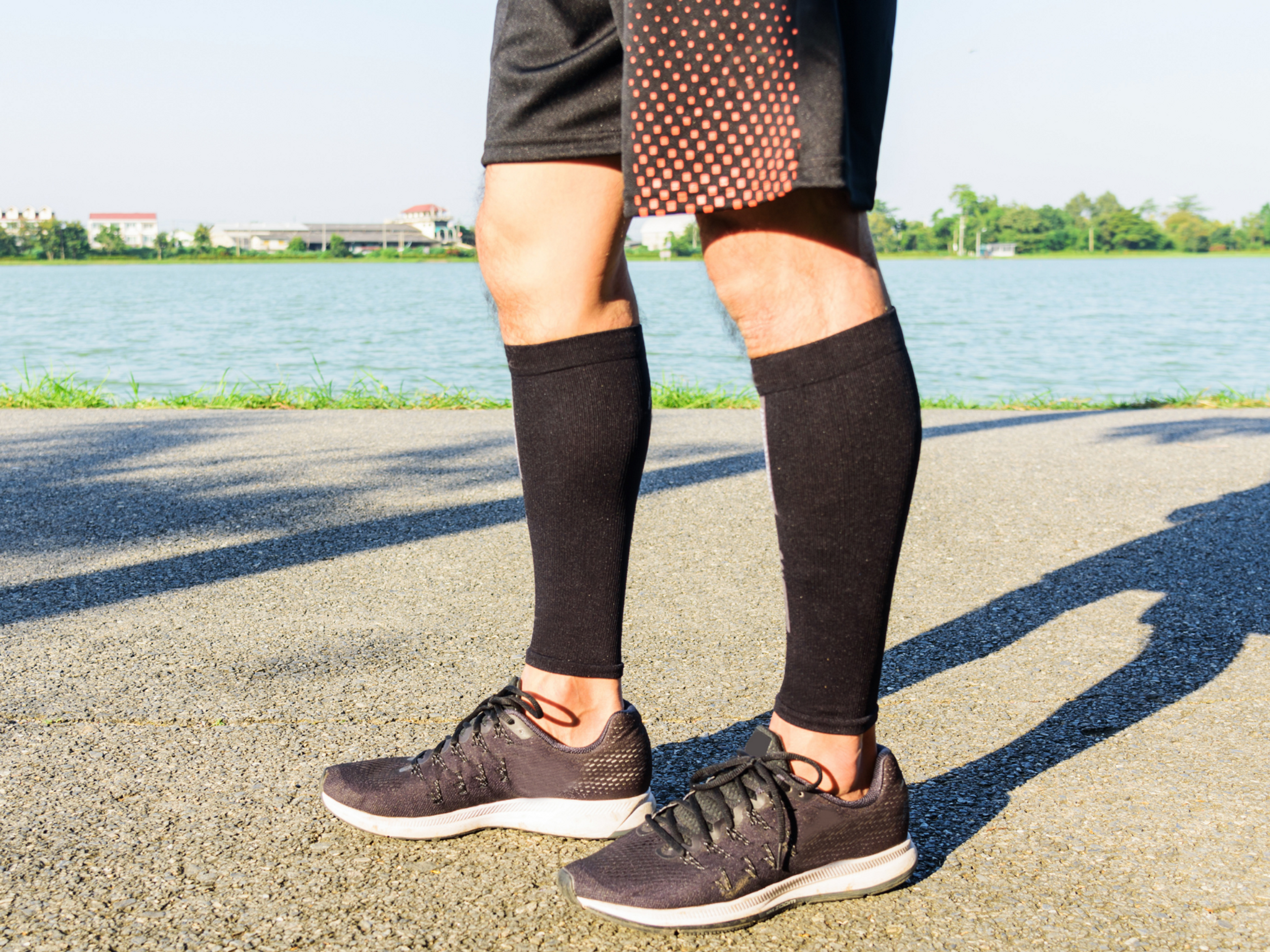Calf strain in runners - Rehabilitation and exercise guide
Before we jump into rehab and exercises, let's first answer some of the most common questions runners have about calf strains.
Can I run with a calf strain?
No, it is best not to run until you've completed your rehabilitation.
Once injured, that part of the calf muscles is no longer as strong as it used to be, making it super easy to strain it even worse if you're not careful.
Why do I keep pulling my calf muscle when running?
The most common cause for repeatedly pulling a calf muscle when running is a lack of proper rehab.
What do we mean by proper rehab?
Research shows that when we run, forces equal to several times our bodyweight go through our calf muscles and Achilles tendons. It's, therefore, crucial to progress your rehabilitation exercises to a point that resembles these forces.
Hopping and jumping exercises (plyometrics) most closely resemble running forces. These have to be introduced in the final rehab stages (more about this below). But even they aren't enough to allow you to return to continuous running immediately.
Carefully easing back into running, using a program that alternates between running and walking is essential to restore your calves' full strength and avoid recurring calf strains.
You can find more information about the different causes of calf strain and how it affects your muscle structure here.
What is the typical calf strain recovery time?
Calf strain recovery usually takes around 4 to 16 weeks, depending on your grade of injury.
How do you treat a strained calf muscle?
Calf strains respond best to a balanced rehab plan consisting of relative rest (allows the injury to settle) and progressive rehab exercises (restore the injured calf's strength).
Treatments like icing your calf strain, wearing compression sleeves, or using kinesiotape can also help reduce pain. You can find a complete list of evidence-based treatments for calf strains here.
A rehab program that builds muscle strength bit by bit is most effective.
Muscles are made up of different types of fibers. Slow-twitch fibers are better for endurance exercise. Fast-twitch fibers are better for short, powerful bursts of activity.
Types of muscle contraction
A comprehensive treatment plan should develop all of these aspects. The Exakt Health App maps the rehab process into 7 stages. In each stage, different exercises target the different muscle fibers and train the different types of contractions, preparing your muscles for the next stage.
By the end of the program, you will have a powerful, resilient calf muscle, and you can get back to running without fear of injury. You can get an overview of the app's calf strain rehabilitation plan here, but we've also discussed it in more detail below.
The 7 stages of calf strain rehabilitation in runners
Stage 1: Acute Stage
At this point, your calf injury is pretty fragile. Your body uses inflammation to eliminate all the injured cells and prepare the area for healing.
Rehab aims
- Protect the calf muscles from further injury.
- Allow the injury to settle.
Treatment consists of the PRICE method
- Protection: Protect your injured calf muscles, stop any activity that causes pain
- Rest: Give your injury time to settle
- Ice: Apply ice over the area for 10 mins at a time (no longer)
- Compression: Use a gentle compression bandage to control swelling
- Elevation: Raise the injured area above the level of the heart
What to avoid
- Positions that stretch your calves may make your injury worse.
- Anti-inflammatory medications (NSAIDs) slow down healing.
- Heat in the first 48 hours increases internal bleeding and swelling.
- Alcohol thins your blood, also increasing bleeding and swelling.
When to progress
- Most people with calf strains should be able to move on to the next stage 48 hours after sustaining their injury.
Stage 2: Sub-Acute Stage
During this period, your body starts to form new cells, but these cells aren't very strong yet.
Rehab aims
- Help the body to align and strengthen the new cells through gentle exercises.
- Main focus is on developing strength and endurance in the slow twitch fibers through low-load concentric and eccentric contractions.
- Include exercises for both the Gastrocnemius and Soleus muscles.
- Keep the rest of your body fit, strong, and flexible to reduce the load on your calf muscles while running.
- Maintain your cardiovascular fitness through activities that do not load the calf, like swimming.
- Limit your walking and other activities to what you can do pain-free.
Examples of Stage 2 calf-specific exercises
What to avoid
- Strong calf stretches
- High load/force activities like jumping and running
When to progress
- When you can walk short distances without pain; and
- You've built good endurance in the soleus and gastrocnemius muscles with low-load (bodyweight) exercises.
Stage 3: Remodelling Stage
Your body has now replaced most of the injured cells, but they still lack the strength and endurance to handle running.
Rehab aims
- Restore full flexibility in your calf muscles.
- Continue building strength in both your slow and fast-twitch muscle fibers by progressing to heavy strength training.
- Include both concentric and eccentric contractions, but emphasize the eccentric component.
- Continue building strength and control in your core and other leg muscles.
- You can now introduce cardiovascular exercise that uses the calf muscles but does not require forceful contractions, like cycling and the cross trainer.
Examples of Stage 3 calf-specific exercises
Once you've mastered doing single-leg calf raises with bodyweight, you should move on to using light weights that tire you within about 15 repetitions (15 Rep Max). You have to increase the weights over time as you gain strength.
What to avoid
- Activities that create strong, forceful contractions, like running, hopping, and jumping
When to progress
- When you can walk 30 minutes at your regular comfortable pace; and
- You can comfortably do your heel raise exercises with weights that equal about 10% of your bodyweight; and
- You can hop pain-free.
Stage 4: Build Explosive Strength
Use this stage to develop the explosive strength you need when running.
Rehab aims
- Develop fast, explosive strength (type 2 muscle fibers) through plyometric exercises.
- Continue building general calf strength through heavy resistance training.
- Carry on with core and general body conditioning.
- Include brisk walking as part of your cardiovascular exercise.
Example of Stage 4 calf-specific exercises
Continue building your calf strength by doing weighted calf raises once or twice a week. You should include at least one session of plyometric exercises in your training week during this stage, which can consist of various hops and jumps.
The rehab plan in the Exakt Health app includes a hop program that starts easy but progresses in volume and intensity over several weeks.
What to avoid
- It may be tempting to run but hold back until you've completed this stage.
When to progress
- When you can walk 30 minutes at a brisk pace; and
- You can comfortably do your heel raise exercises with weights that equal about 20% of your bodyweight; and
- You can complete your plyometric sessions pain-free.
Stage 5: Return to Running
The forces your calf muscles produce and absorb during running are much higher than those they have to tolerate when you walk. The best way to avoid reinjury is to ease slowly back into running using a walk-and-run program.
Rehab aims
- Help your calf muscles adapt to the increased forces by following a walk-and-run program.
- Maintain your calf and general strength by doing 1 to 2 strength training sessions a week.
Stage 5 calf-specific exercises
Once you start running, you should drop the plyometric exercises and just keep a maintenance dose of heel raises in your program.
Take care not to overtrain
Walk-and-run program
Although you may be excited to finally be able to run again, it's crucial that you keep it slow, controlled, and pain-free.
The app includes a walk-and-run program that starts with 1-minute intervals and gradually builds your endurance until you can run continuously for 20 minutes.
What to avoid
- High-intensity sessions like tempo runs, intervals, or hill sessions: These types of runs work the calves much harder, and your muscles need a bit more preparation before moving on to those.
When to progress
- You're ready to move on to the next stage when you can run continuously for 20 minutes.
Stage 6: Build Easy Run Endurance
Easy running places a lot less force on your calf muscles than fast running. That's why you should always first build your slow-running mileage to what you could do pre-injury.
Rehab aims
- Regain your calf's previous slow running endurance.
- Maintain the strength you've built in the earlier stages.
Stage 6 calf-specific exercise
You can maintain your calf strength by doing 1 to 2 strength training sessions per week, using weights that fatigue your calves within about 10 repetitions (10 rep max).
What to avoid
- High-intensity runs like sprints, tempo, or hill sessions
When to progress
- You're ready to progress to the final stage once you can complete your preinjury weekly running volumes at your regular easy pace.
Stage 7: Build Running Intensity and Speed
High-intensity running workouts place the most strain on your calves and should only be included once you've fully restored your easy running endurance.
Rehab aims
- Develop your calf's ability to withstand high-intensity workouts like hill sessions, tempo runs, and sprinting.
- Maintain the strength and control in the rest of your body.
Stage 7 calf-specific exercise
You can continue with the same maintenance exercises as in stage 6. The main difference is that you will add some high-intensity running sessions to your regular training week.
It's usually best to start with just one session per week, but what you can do will depend on various factors.
We understand. We've been there. Finding convenient and reliable help for injuries online can be a tedious and demoralizing process. Here's our story and why we started Exakt Health.
The Exakt Health App provides runners with a convenient, intuitive, science-based injury rehab experience.
All treatment advice is based on trusted medical evidence and reviewed by licensed sports physiotherapists, with each rehabilitation plan tailored to your unique grade of injury and phase of healing. Download the Exakt Health App and start your recovery now.





